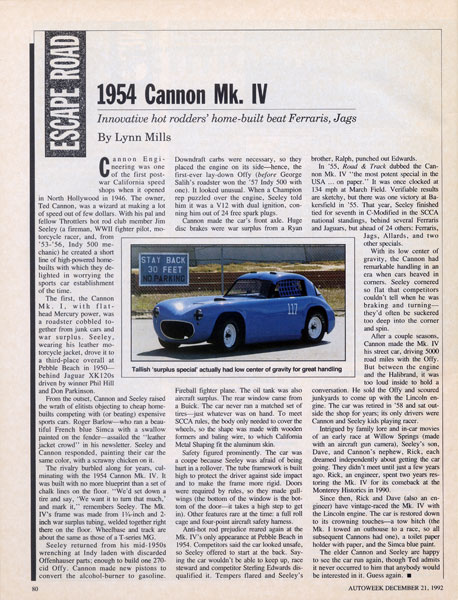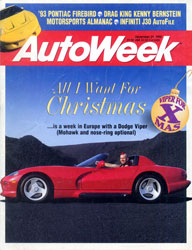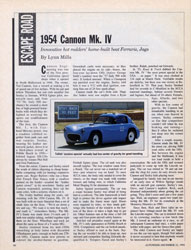
Escape Road
1954 Cannon Mk. IV
Innovative hot rodders' home-built beat Ferraris, Jags
By Lynn Mills
Cannon Engineering was one of the first post-war California speed shops when it opened in North Hollywood in 1946. The owner, Ted Cannon, was a wizard at making a lot of speed out of few dollars. With his pal and fellow Throttlers hot rod club member Jan Seeley (a fireman, WWII fighter pilot, motorcycle racer, and, from '53-'56, Indy 500 mechanic) he created a short line of high-powered homebuilts with which they delighted in worrying the sports car establishment of the time. The first, the Cannon Mk. I, with flathead Mercury power, was a roadster cobbled together from junk cars and war surplus. Seeley, wearing his leather motorcycle jacket, drove it to third-place overall at Pebble Beach in 1950 -- behind Jaguar XK120s driven by winner Phil Hill and Don Parkinson. From the outset, Cannon and Seeley raised the wrath of elitists objecting to cheap homebuilts competing with (or beating) expensive sports cars. Roger Barlow -- who ran a beautiful French blue Simca with a swallow painted on the fender -- assailed the "leather jacket crowd" in his newsletter. Seeley and Cannon responded, painting their car the same color, with a scrawny chicken on it. The rivalry bubbled along for years, cuminating with the 1954 Cannon Mk. IV. It was built with no more blueprint than a set of chalk lines on the floor. "We'd set down a tire and say, 'We want it to turn that much,' and mark it," remembers Seeley. The Mk. IV's frame was made from 1 1/4 inch and 2 inch surplus tubing, welded together right there on the floor. Wheelbase and track are about the same as those of a T-series MG. Seeley returned from his mid-1950s wrenching at Indy laden with discarded Offenhauser parts; enough to build one 270 cid Offy. Cannon made new pistons to convert the alcohol-burner to gasoline. Downdraft carbs were necessary, so they placed the engine on its side -- hence, the first-ever lay-down Offy (before George Smith's roadster won the '57 Indy 500 with one). It looked unusual. WHen a Champion rep puzzled over the engine, Seeley told him it was a V12 with dual ignition, conning him out of 24 spark plugs. Cannon made the car's front axle. Huge disc brakes were war surpus from a Ryan Fireball fighter plane. The oil tank was also aircraft surplus. The rear window came from a Buick. The car never ran a matched set of tires -- just whatever was on hand. To meet SCCA rules, the body only needed to cover the wheels, so the shape was made with wooden formers and baling wire, to which California Metal Shaping fit the aluminum skin. Safety figured prominently. The car was a coupe because Seeley was afraid of being hurt in a rollover. The tube framework is built high to protect the driver against side impact and to make the frame more rigid. Doors were required by rules, so they made gullwings (the bottom of the window is the bottom of the door -- it takes a high step to get in). Other features rare at the time: a full roll cage and four-point aircraft safety harness. Anti-hot rod prejudice reared again at the Mk. IV's only appearance at Pebble Beach in 1954. Competitors said the car looked unsafe, so Seeley offered to start at the back. Saying the car wouldn't be able to keep up, race steward and competitor Sterling Edwards disqualified it. Tempers flared and Seeley's brother, Ralph, punched out Edwards. In '55, Road & Track dubbbed the Cannon Mk. IV "the most potent special in the USA... on paper." It was once clocked at 134 mph at March Field. Verifiable results are sketchy, but there was one victory at Bakersfield in '55. That year, Seeley finished tied for seventh in C-Modified in the SCCA national standings, behind several Ferraris and Jaguars, but ahead of 24 others; Ferraris, Jags, Allards, and two other specials. With its low center of gravity, the Cannon had remarkable handling in an era when cars heaved in corners. Seeley cornered so flat that competitors couldn't tell when he was braking and turning -- they'd often be suckered too deep into the corner and spin. After a couple seasons, Cannon made the Mk. IV his street car, driving 5000 miles with the Offy. But between the engine and the Halibrand, it was too loud inside to hold a conversation. He sold the Offy and scrounged junkyards to come up with the Lincoln engine. The car was retired in '58 and sat outside the shop for years, it only drivers were Cannon and Seeley kids playing racer. Intrigued by family lore and in-car movies of an early race at Willow Springs (made with an aircraft gun camera), Seeley's son, Dave, and Cannon's nephew, Rick, each dreamed independently about getting the car going. They didn't meet until just a few years ago. Rick, an engineer, spent two years restoring the Mk. IV for its comeback at the Monterey Historics in 1990. Since then, Rick and Dave (also an engineer) have vintage-raced the Mk. IV with the Lincoln engine. The car is restored down to its crowning touches -- a two hitch (the Mk. I towed an outhouse to a race, so all subsequent Cannons had one), a toilet paper holder with paper, and the Simca blue paint. The elder Cannon and Seeley are happy to see the car run again, though Ted admits it never occurred to him that anyone would be interested in it. Guest again. |

